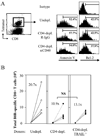Recall responses by helpless memory CD8+ T cells are restricted by the up-regulation of PD-1
- PMID: 19299723
- PMCID: PMC2713929
- DOI: 10.4049/jimmunol.0802041
Recall responses by helpless memory CD8+ T cells are restricted by the up-regulation of PD-1
Abstract
CD4 help is crucial for memory CD8(+) T cell development, yet the mechanisms of CD4 help and why (CD4) helpless memory CD8(+) T cells elicit poor recall responses are currently not well understood. In this study we investigated these questions using an in vivo acute virus infection model. We show herein that CD4 help during priming is required for memory CD8(+) T cell differentiation, and that stimulation of CD40 during priming rescues the helpless defects in the absence of CD4(+) T cells. The defective recall response by helpless memory cells did not correlate with the amount of cell death and was independent of TRAIL. However, helpless memory cells excessively up-regulated the inhibitory receptor PD-1 (programmed cell death-1), and PD-1 blockade enhanced the recall response of helpless memory cells. Furthermore, providing IL-2 signaling in vivo during the recall response reduced PD-1 expression and rescued the recall response of helpless memory cells. Our study identifies molecular pathways involved in CD4 help for memory CD8(+) T cell generation that are independent of TRAIL, and it provides therapeutic implications that helpless memory cell function can be restored at multiple stages through various immunological interventions.
Figures










Similar articles
-
Programmed death 1 regulates development of central memory CD8 T cells after acute viral infection.J Immunol. 2011 Jun 1;186(11):6280-6. doi: 10.4049/jimmunol.1003870. Epub 2011 Apr 27. J Immunol. 2011. PMID: 21525385 Free PMC article.
-
T-cell help dependence of memory CD8+ T-cell expansion upon vaccinia virus challenge relies on CD40 signaling.Eur J Immunol. 2014 Jan;44(1):115-26. doi: 10.1002/eji.201343805. Epub 2013 Oct 24. Eur J Immunol. 2014. PMID: 24108445
-
CD4+ T-cell help controls CD8+ T-cell memory via TRAIL-mediated activation-induced cell death.Nature. 2005 Mar 3;434(7029):88-93. doi: 10.1038/nature03337. Nature. 2005. PMID: 15744305
-
CD8 T cell memory development: CD4 T cell help is appreciated.Immunol Res. 2007;39(1-3):94-104. doi: 10.1007/s12026-007-0081-4. Immunol Res. 2007. PMID: 17917058 Review.
-
Enhancement of proliferation and downregulation of TRAIL expression on CD8+ T cells by IL-21.Eur J Immunol. 2010 Nov;40(11):2990-2. doi: 10.1002/eji.201041076. Eur J Immunol. 2010. PMID: 21064084 Free PMC article. Review.
Cited by
-
CD4 T cells control development and maintenance of brain-resident CD8 T cells during polyomavirus infection.PLoS Pathog. 2018 Oct 29;14(10):e1007365. doi: 10.1371/journal.ppat.1007365. eCollection 2018 Oct. PLoS Pathog. 2018. PMID: 30372487 Free PMC article.
-
PD-1/PD-L1 Blockade: Have We Found the Key to Unleash the Antitumor Immune Response?Front Immunol. 2017 Dec 4;8:1597. doi: 10.3389/fimmu.2017.01597. eCollection 2017. Front Immunol. 2017. PMID: 29255458 Free PMC article. Review.
-
CD40 signaling to the rescue: A CD8 exhaustion perspective in chronic infectious diseases.Crit Rev Immunol. 2013;33(4):361-78. doi: 10.1615/critrevimmunol.2013007444. Crit Rev Immunol. 2013. PMID: 23971530 Free PMC article.
-
Early events governing memory CD8+ T-cell differentiation.Int Immunol. 2010 Aug;22(8):619-25. doi: 10.1093/intimm/dxq053. Epub 2010 May 26. Int Immunol. 2010. PMID: 20504887 Free PMC article. Review.
-
Blockade of programmed death-1 in young (New Zealand Black x New Zealand White)F1 mice promotes the suppressive capacity of CD4+ regulatory T cells protecting from lupus-like disease.J Immunol. 2013 Jun 1;190(11):5402-10. doi: 10.4049/jimmunol.1202382. Epub 2013 May 1. J Immunol. 2013. PMID: 23636058 Free PMC article.
References
-
- Kaech SM, Wherry EJ, Ahmed R. Effector and memory T-cell differentiation: implications for vaccine development. Nat Rev Immunol. 2002;2:251–262. - PubMed
-
- Janssen EM, Lemmens EE, Wolfe T, Christen U, von Herrath MG, Schoenberger SP. CD4+ T cells are required for secondary expansion and memory in CD8+ T lymphocytes. Nature. 2003;421:852–856. - PubMed
-
- Shedlock DJ, Shen H. Requirement for CD4 T cell help in generating functional CD8 T cell memory. Science. 2003;300:337–339. - PubMed
-
- Khanolkar A, Fuller MJ, Zajac AJ. CD4 T cell-dependent CD8 T cell maturation. J Immunol. 2004;172:2834–2844. - PubMed
Publication types
MeSH terms
Substances
Grants and funding
LinkOut - more resources
Full Text Sources
Other Literature Sources
Molecular Biology Databases
Research Materials

